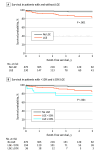Myocardial Scarring and Sudden Cardiac Death in Young Patients With Hypertrophic Cardiomyopathy: A Multicenter Cohort Study
- PMID: 39320884
- PMCID: PMC11425184
- DOI: 10.1001/jamacardio.2024.2824
Myocardial Scarring and Sudden Cardiac Death in Young Patients With Hypertrophic Cardiomyopathy: A Multicenter Cohort Study
Erratum in
-
Error in Byline.JAMA Cardiol. 2025 Mar 1;10(3):300. doi: 10.1001/jamacardio.2024.5630. JAMA Cardiol. 2025. PMID: 39878992 Free PMC article. No abstract available.
Abstract
Importance: The ability to predict sudden cardiac death (SCD) in children and adolescents with hypertrophic cardiomyopathy (HCM) is currently inadequate. Late gadolinium enhancement (LGE) by cardiovascular magnetic resonance (CMR) imaging is associated with SCD events in adults with HCM.
Objective: To examine the prognostic significance of LGE in patients with HCM who are younger than 21 years.
Design, setting, and participants: This multicenter, retrospective cohort study was conducted from April 8, 2015, to September 12, 2022, in patients with HCM who were younger than 21 years and had undergone CMR imaging across multiple sites in the US, Europe, and South America. Observers of CMR studies were masked toward outcomes and demographic characteristics.
Exposure: Natural history of HCM.
Main outcome and measures: The primary outcome was SCD and surrogate events, including resuscitated cardiac arrest and appropriate discharges from an implantable defibrillator. Continuous and categorical data are expressed as mean (SD), median (IQR), or number (percentage), respectively. Survivor curves comparing patients with and without LGE were constructed by the Kaplan-Meier method, and likelihood of subsequent clinical events was further evaluated using univariate and multivariable Cox proportional hazards models.
Results: Among 700 patients from 37 international centers, median (IQR) age was 14.8 (11.9-17.4) years, and 518 participants (74.0%) were male. During a median (IQR) [range] follow-up period of 1.9 (0.5-4.1) [0.1-14.8] years, 35 patients (5.0%) experienced SCD or equivalent events. LGE was present in 230 patients (32.9%), which constituted an mean (SD) burden of 5.9% (7.3%) of left ventricular myocardium. The LGE amount was higher in older patients and those with greater left ventricular mass and maximal wall thickness; patients with LGE had lower left ventricular ejection fractions and larger left atrial diameters. The presence and burden of LGE was associated with SCD, even after correcting for existing risk stratification tools. Patients with 10% or more LGE, relative to total myocardium, had a higher risk of SCD (unadjusted hazard ratio [HR], 2.19; 95% CI, 1.59-3.02; P < .001). Furthermore, the addition of LGE burden improved the performance of the HCM Risk-Kids score (before LGE addition: 0.66; 95% CI, 0.58-0.75; after LGE addition: 0.73; 95% CI, 0.66-0.81) and Precision Medicine in Cardiomyopathy score (before LGE addition: 0.68; 95% CI, 0.49-0.77; after LGE addition: 0.73; 95% CI, 0.64-0.82) SCD predictive models.
Conclusions and relevance: In this retrospective cohort study, quantitative LGE was a risk factor for SCD in patients younger than 21 years with HCM and improved risk stratification.
Conflict of interest statement
Figures
References
-
- Ommen SR, Mital S, Burke MA, et al. 2020 AHA/ACC Guideline for the Diagnosis and Treatment of Patients With Hypertrophic Cardiomyopathy: Executive Summary: a report of the American College of Cardiology/American Heart Association Joint Committee on Clinical Practice Guidelines. J Am Coll Cardiol. 2020;76(25):3022-3055. doi: 10.1016/j.jacc.2020.08.044 - DOI - PubMed
Publication types
MeSH terms
Substances
LinkOut - more resources
Full Text Sources
Miscellaneous


